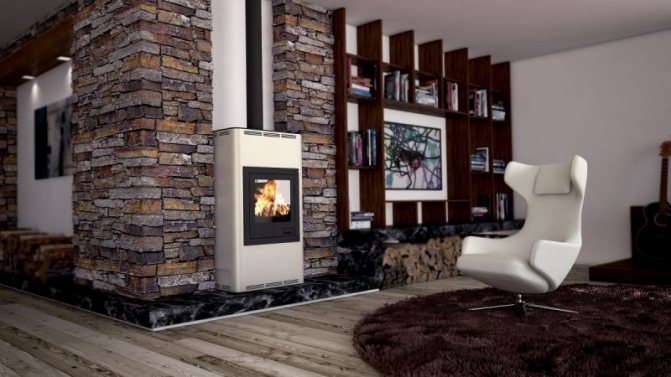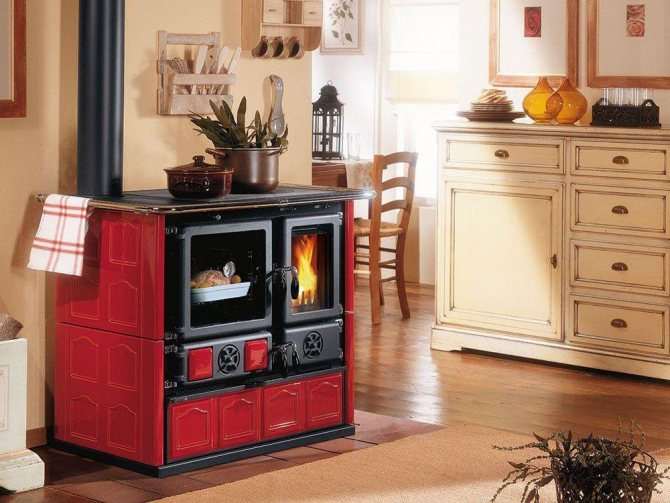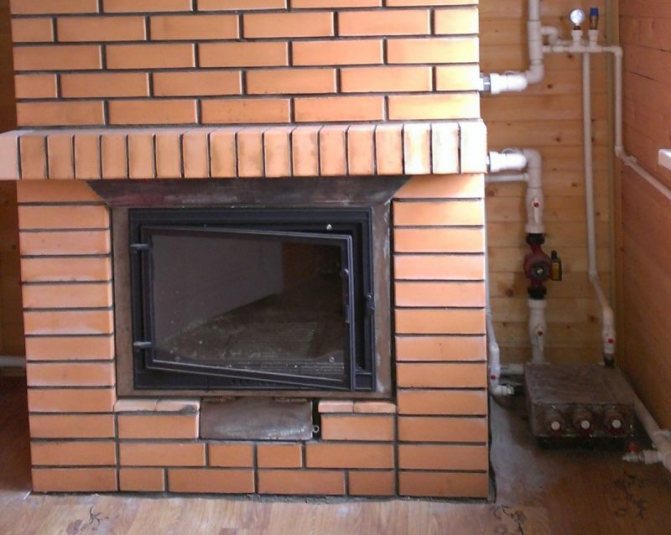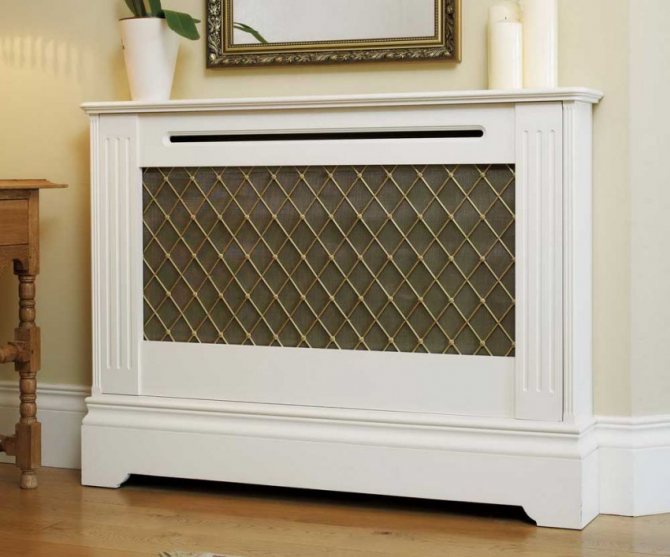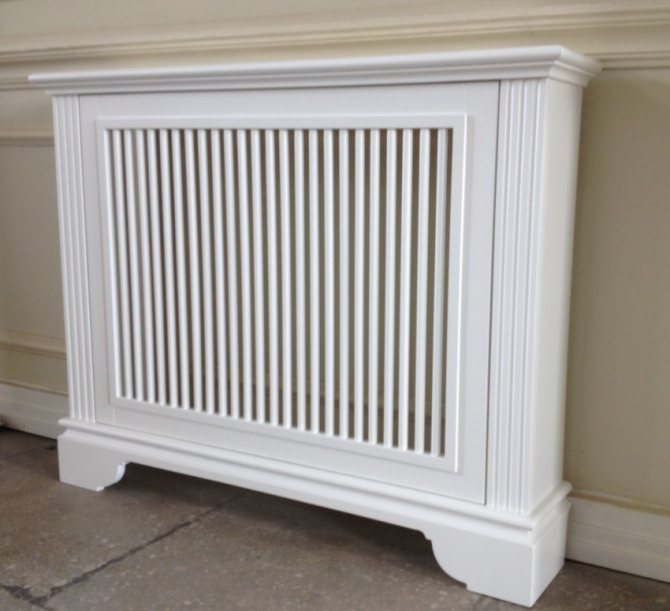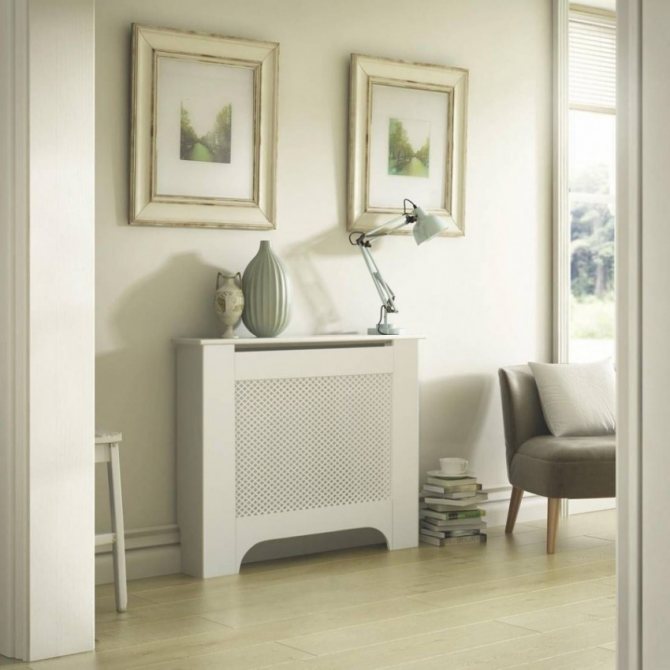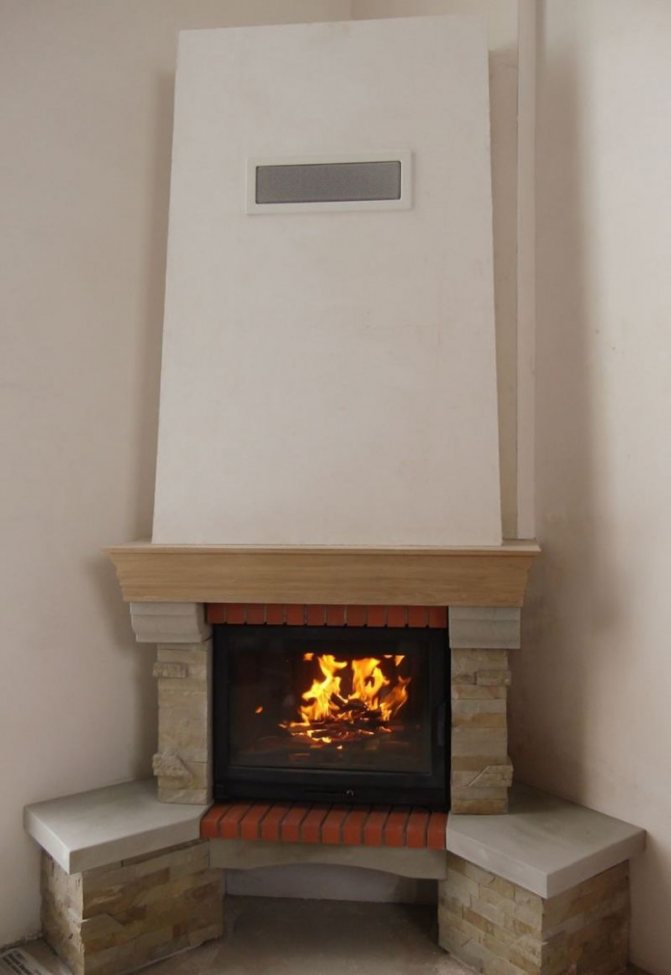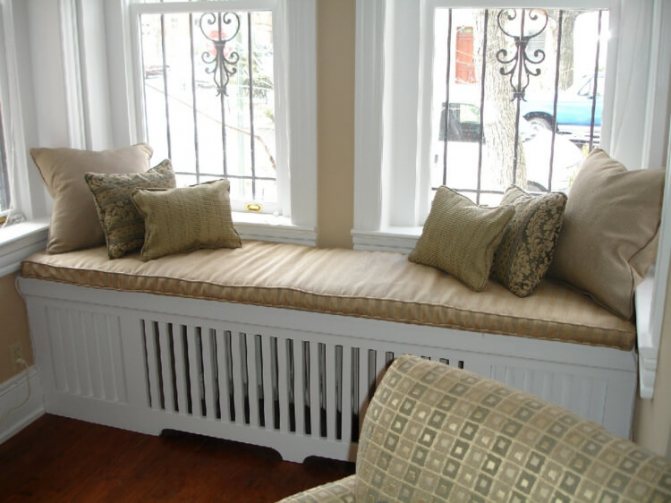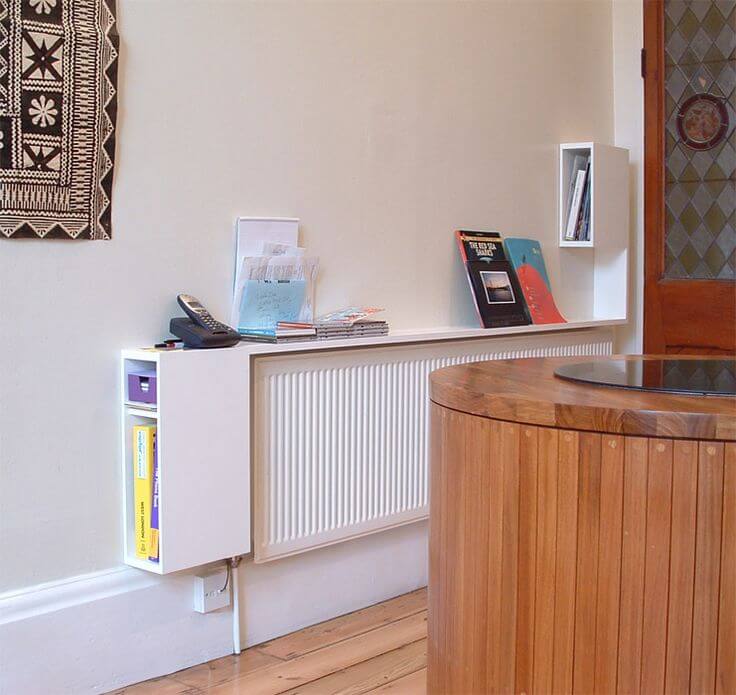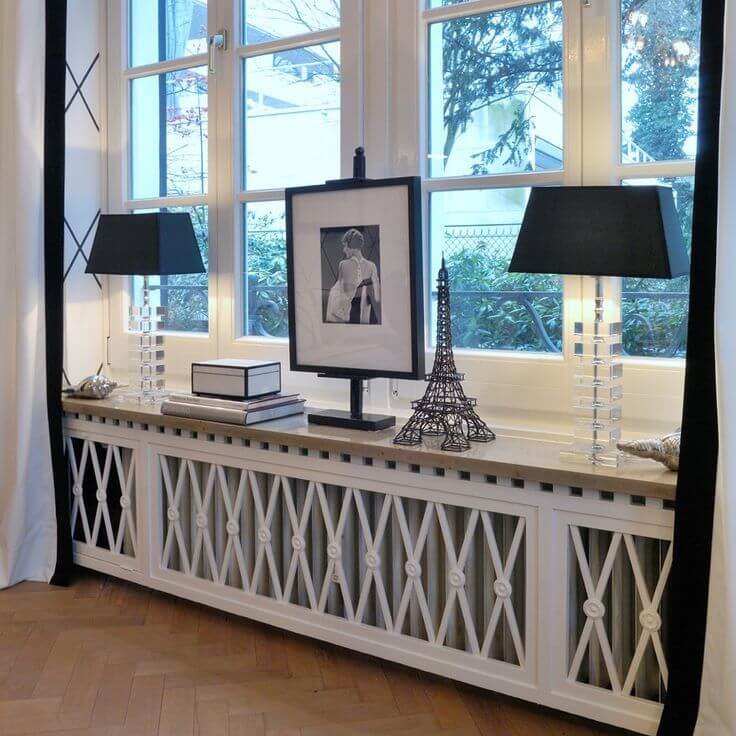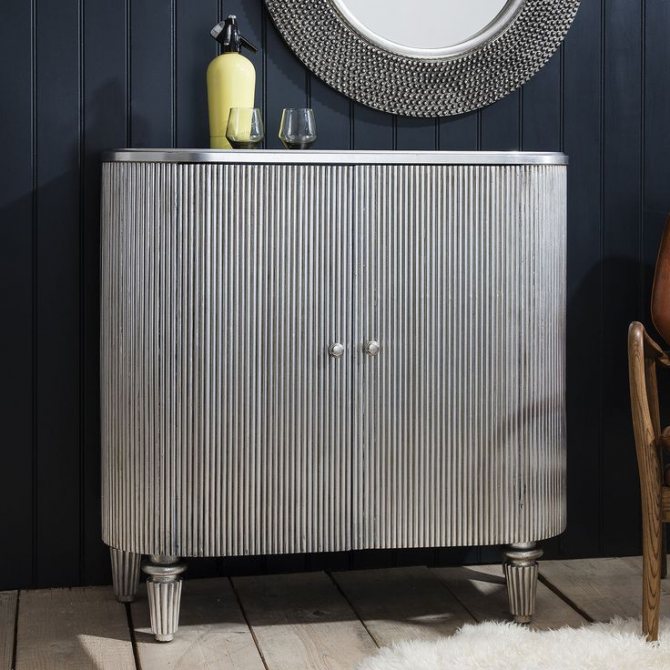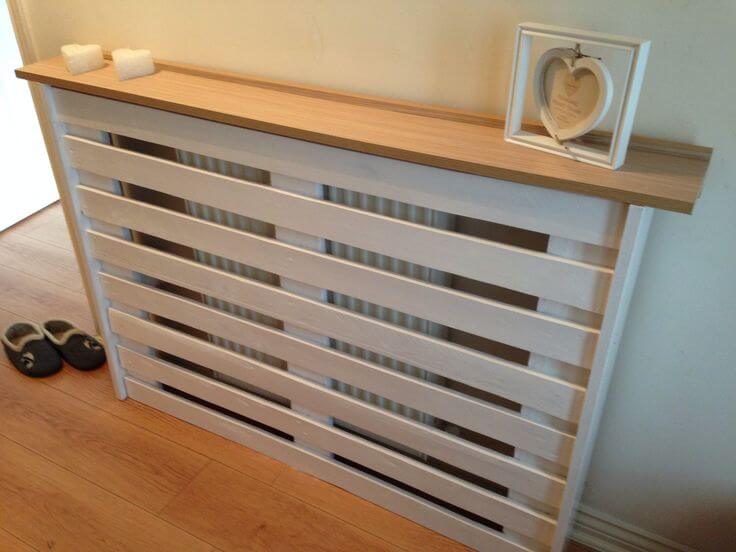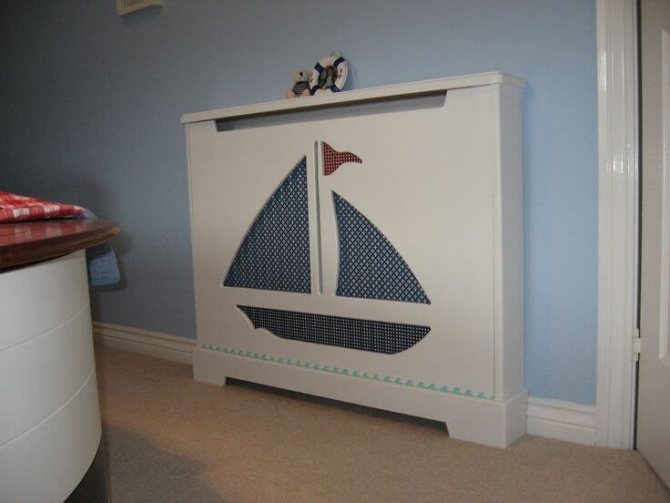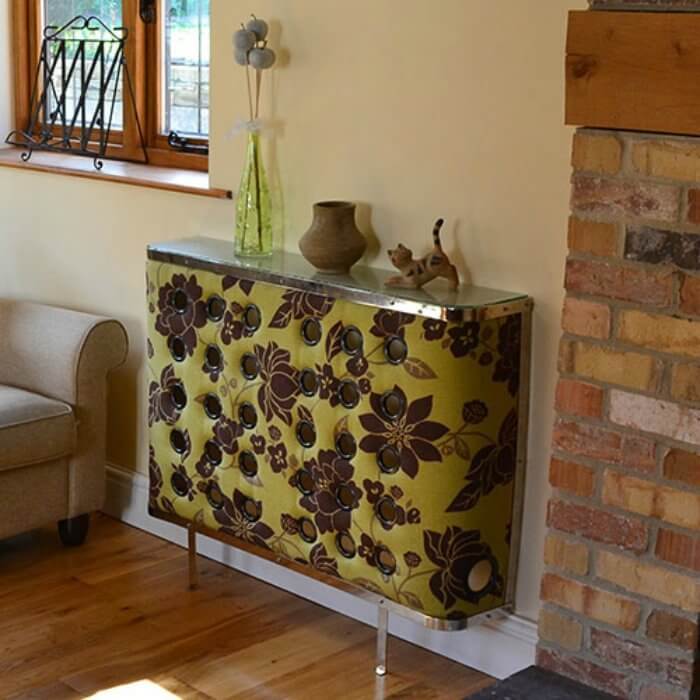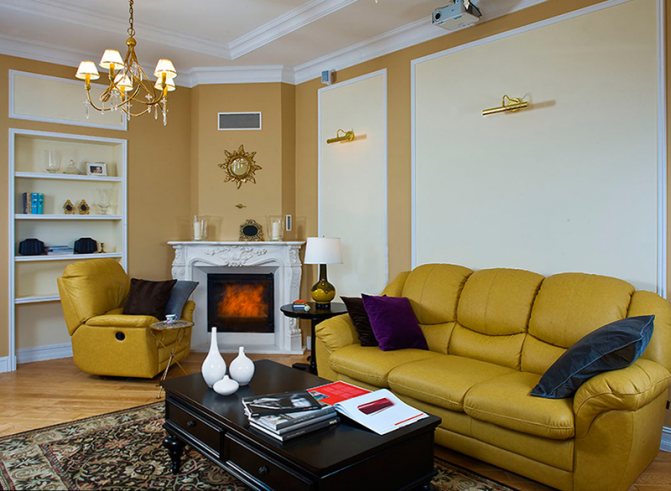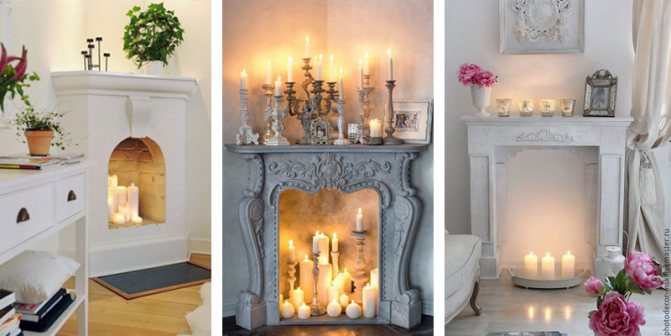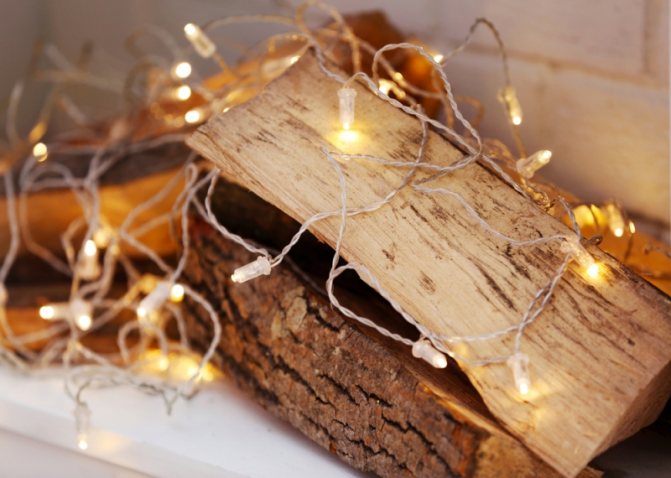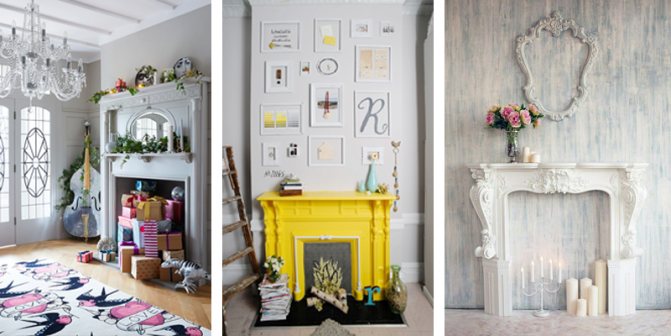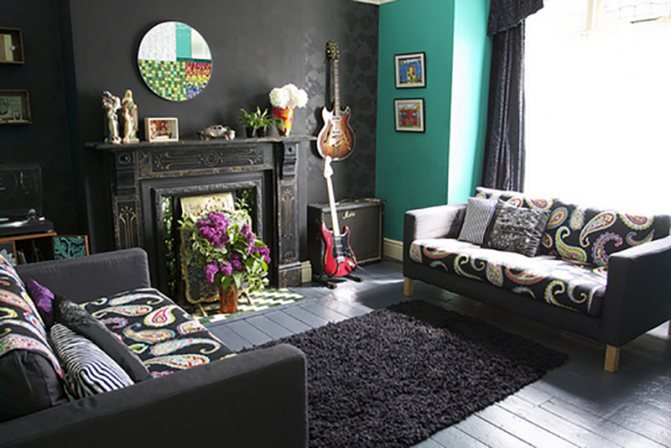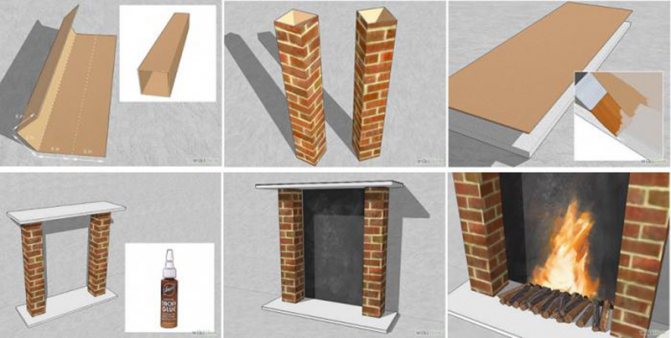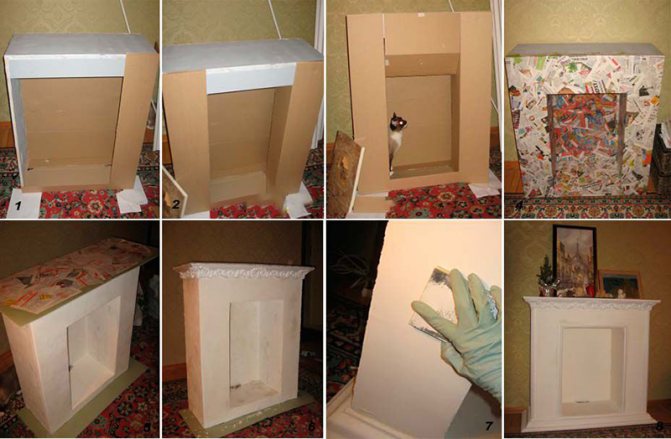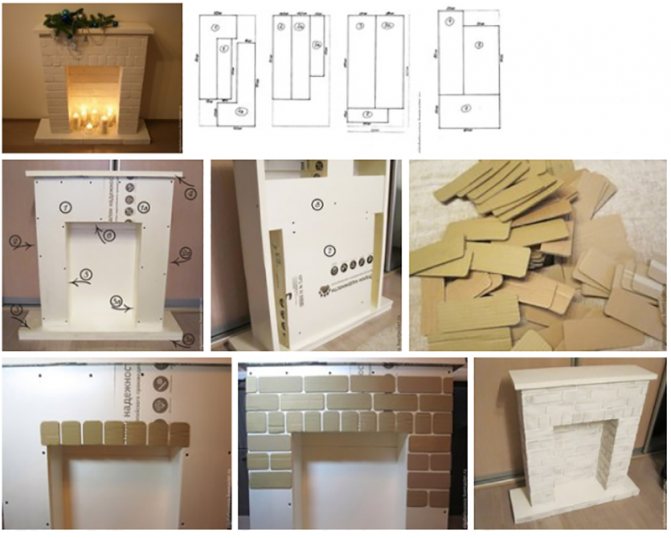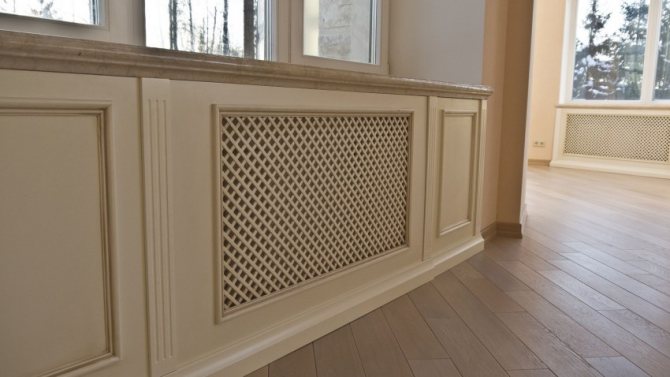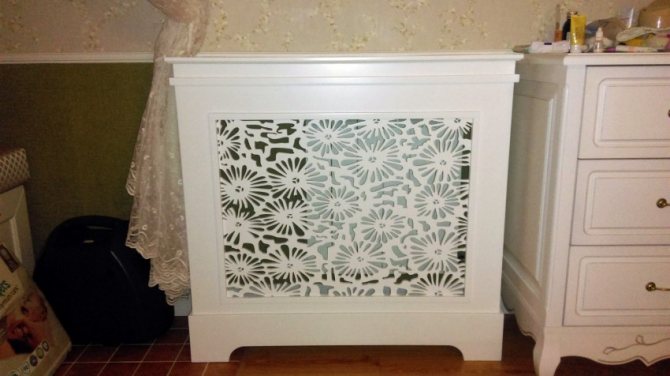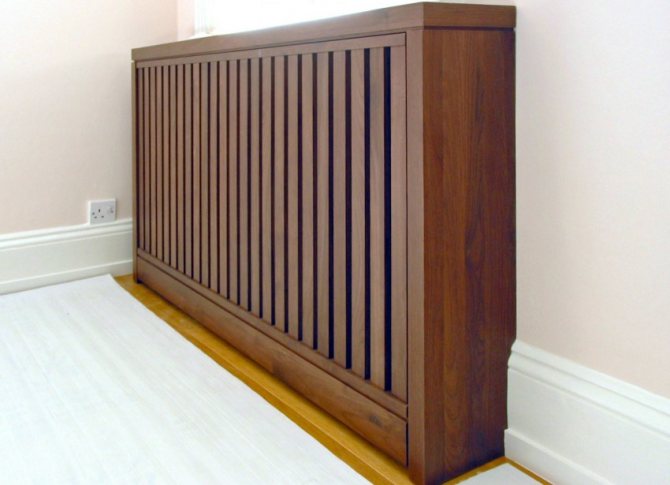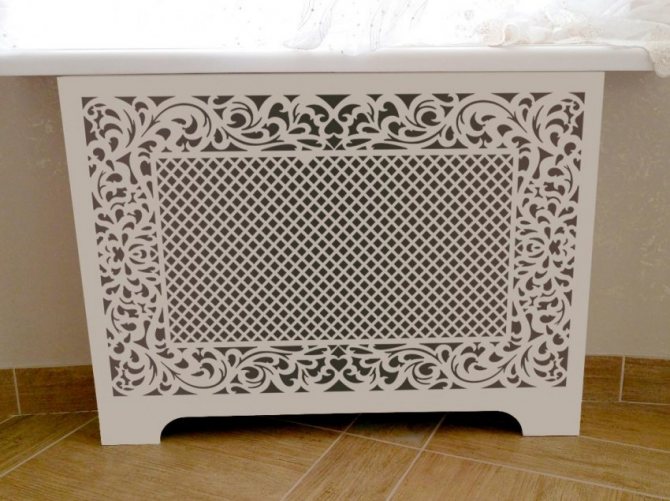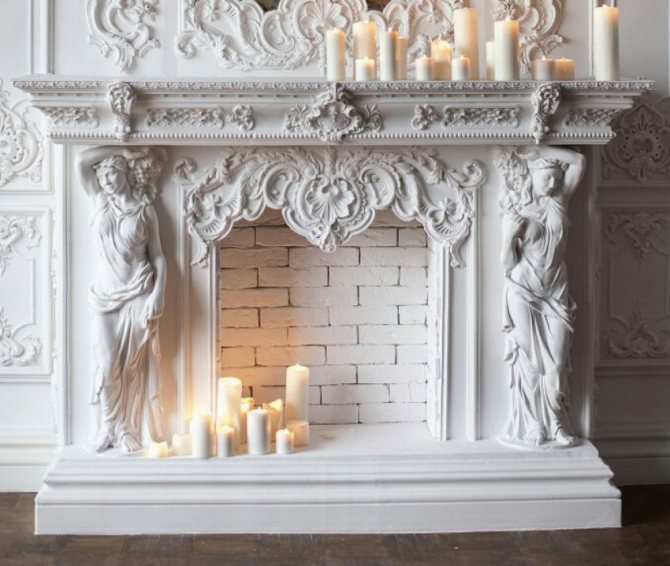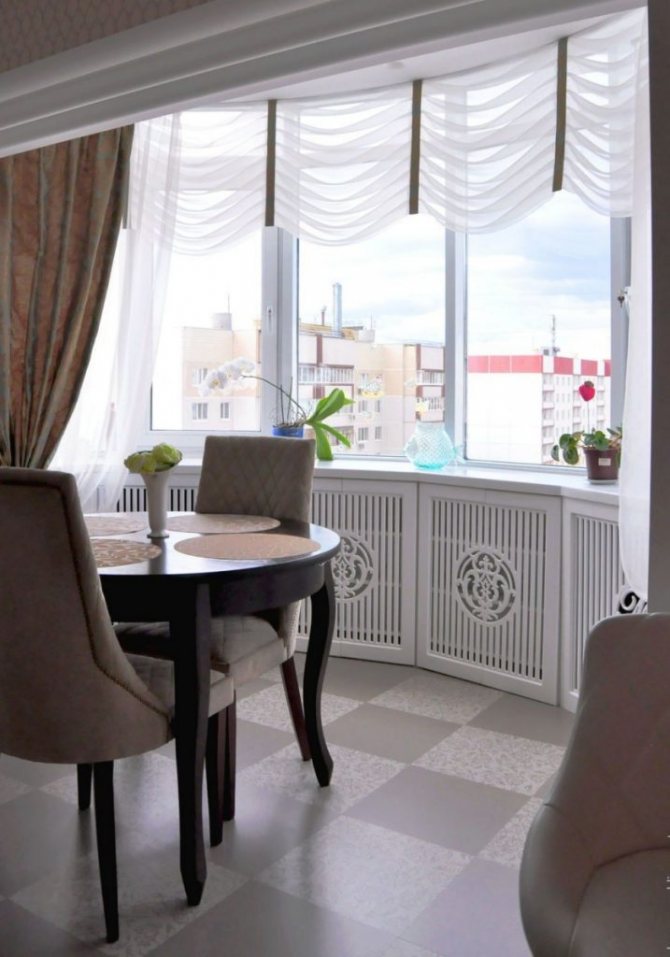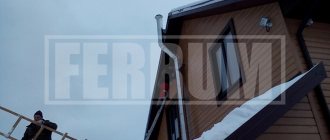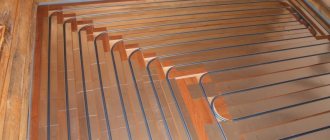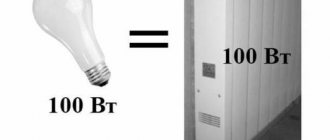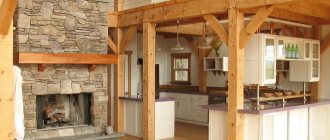Any owner of a private house dreams of a large fireplace, which in itself creates an atmosphere of warmth and comfort. The whole family will gather near an open fire on dark, winter evenings, exchanging events for the day. However, modern fireplaces are not just a decorative part of the interior. A well-done modernization turns the fireplace with a water heating circuit into a full-fledged source of heat for the whole house, along with the generally recognized factory-made heating equipment.
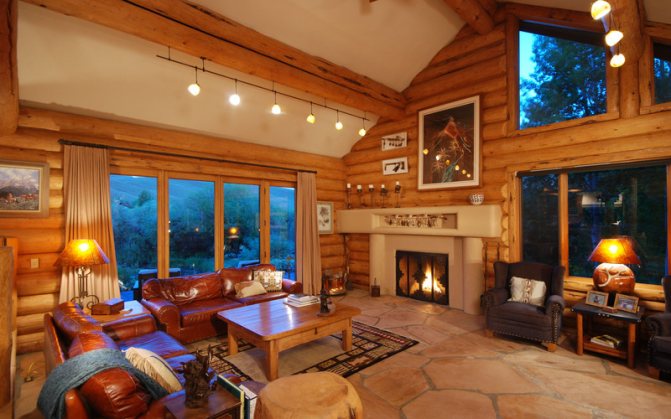
As practice shows, fireplaces for air heating at home and equipped with a water circuit also help to significantly save on energy consumption. After all, solid fuel costs somewhat less than the price of electricity and gas.
What is a fireplace with a water heating circuit?
A fireplace is a type of heating equipment where heat is generated by burning primary fuel. It can be wood, coal, pellets. There are gas fireplaces for heating.
Fireplace equipment can be:
- with open and closed fireboxes;
- water and air heating circuits;
- natural and forced air flow;
- built-in and free-standing.
The main distinguishing feature of the heater is an open combustion chamber.
The heat generation area and the fuel oxidation zone (process zone) are combined here, which reduces the percentage of heating of the environment as a result of natural air convection. Most of the room temperature rises due to radiant energy (IR waves).
The main disadvantage of the above-described scheme of heat exchange between the fireplace and the environment is significant heat losses from the combustion products of the energy carrier leaving the combustion chamber through a brick chimney. The built-in water circuit, which is integrated into the wiring of the home heating system, allowed to increase the efficiency of the heating equipment. That is, a fireplace with a water heating circuit heats the room both through the formation of infrared waves, and according to the principle of a conventional boiler, heating the coolant in the radiators.
Battery decor: plumbing tips
The second, no less important point is the availability of the radiator and supply pipes. It's no secret that the battery is one of the potential sources of problems in an apartment. Any radiator can leak - there are many reasons for this, from water hammer to low-quality material. In addition, given the low quality of the coolant (water), it may be necessary to remove the battery in order to flush it - otherwise, the number of actively heating sections will constantly decrease. So from the point of view of plumbing, the best cover (panel) on the battery should provide free access to the radiator - either not have a permanent attachment, or be attached.
The decor of the battery should provide free access to it
Advice! At the very least, it is necessary to put a "revision" (plastic door), which will give access to the place where the pipe is supplied to the radiator - as experience shows, this is the weakest point in the entire system.
How to close the battery - we are considering the options in the video:
It's hard to find a more boring item in your home than radiators.
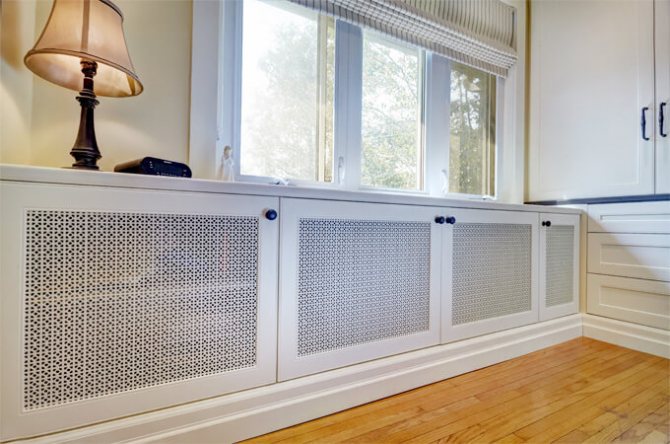

It is absolutely unimportant in what style the interior of the room is sustained, if the view is spoiled by the awkward structures placed in each room of the dwelling. They can be closed with decorative elements, but if you have imagination, you can really come up with an interesting design of an integral attribute of an apartment.
With a stable financial situation, you can purchase elegant radiators of popular brands, which will be designed in any suitable interior style (retro, art deco, hi-tech, modern, provence). If your soul asks for something unusual, you can create a radiator decor with your own hands.
Making a reading space above the radiator by the window To disguise an unsightly heating radiator, a reading bench is made. It will be a stylish piece of the bedroom. The best way to decorate the battery is to install a special neat grille right under the window. Thus, the heating element will not be visible at all: instead of it, a neat decorative grille will flaunt.
The advantage of this design solution is the aesthetic and practical moment: thanks to the battery under the windowsill, you don't have to worry about cold sitting in winter. The radiator will warm up the resting place, so you can comfortably spend time with a book in your hands. The grille is matched to the overall color scheme of the interior. White will look most successful.
The decor of the radiator involves the use of different screens. It is important not to block the flow of warm air and to use materials that do not lose their basic qualities due to constant exposure to high temperatures.
Structures can be hinged and resting on the floor covering. An effective design solution is the use of a box-screen in the form of a curbstone with doors. It can become a kind of table. A decorative screen is needed for the reason that the room looks aesthetically pleasing.
Most of the available radiators do not shine with aesthetics and have some problems due to functional features. A radiator is a product that has a complex design and is necessary to ensure high heat transfer rates between the battery case and the environment. This interior element has two significant drawbacks.
The first one is sharp corners, about which you can get hurt, tear clothes, curtains, expensive curtains. The second is an inconvenient design, constantly clogged with dust. Because of this, it is difficult to clean the radiator, and with an impressive accumulation of cobwebs, it looks ugly. There are two criteria according to which they can be divided into the following: by the type of construction and the material from which they are made.
If you pay attention to the principles of dividing into categories, you get the following: By design, screens are:
Flat
Such decorative elements are more often used for batteries in a niche, when they are located in the area under the windowsill and are framed by a wall. It should be noted right away that ventilation holes must be installed in the window sill itself. This is necessary to circulate air from the radiator. Otherwise, the advisability of mounting the battery will be minimal. At the moment, this type of screen is considered the simplest and most affordable.
Hinged
Used for radiators that are installed on the wall plane. The screen is mounted on the radiator itself and acts as a so-called housing. A significant disadvantage of this design is that the radiators must also be designed for the mass of the screen. When choosing such a design, you need to pay attention to the moment that the plane of the screen must necessarily have holes. This allows the warm air to circulate better.
Equipment device
The heart of the fireplace is a steel casing (16). The combustion chamber (1) is mounted in it. The cast iron door (2) prevents heat from escaping from the combustion chamber. For this, it is equipped with tempered glass (3) and a bolt (4). The combustion chamber casing (5) is connected to the frame using cast iron axles. The bottom of the firebox is made of heavy-plate cast iron (6). The grates are laid on top of it (10).
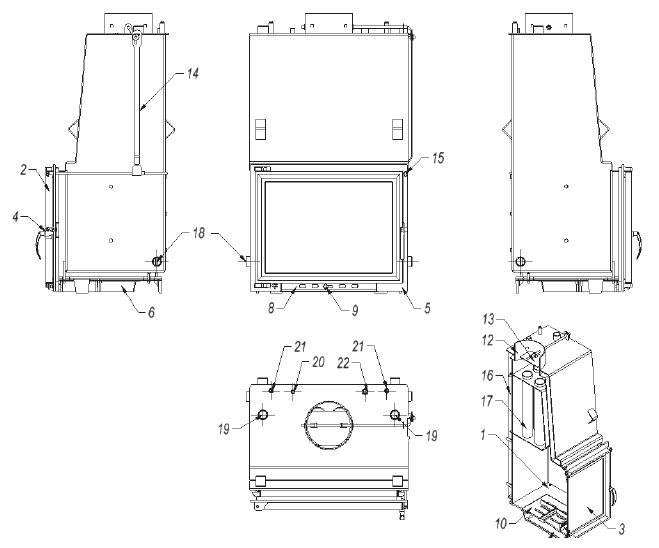

Fireplace complete set.
Today, a fireplace heating element can be bought on the market for similar equipment. However, some people want to make a DIY fireplace with water heating. To do this, you need to familiarize yourself with its device in more detail.
They also have an impressive thickness, since there is a direct oxidation reaction of the energy carrier. Gas fireplaces for heating do not have a grate, since ash does not form here, which should accumulate in the ash pan. The combustion chamber has a cast iron fence (11). It also serves as a decorative function, and acts as an additional protection against the fallout of burning fuel. The ash pan (7) at the bottom of the device is necessary to collect solid combustion products. It must be retractable without fail.
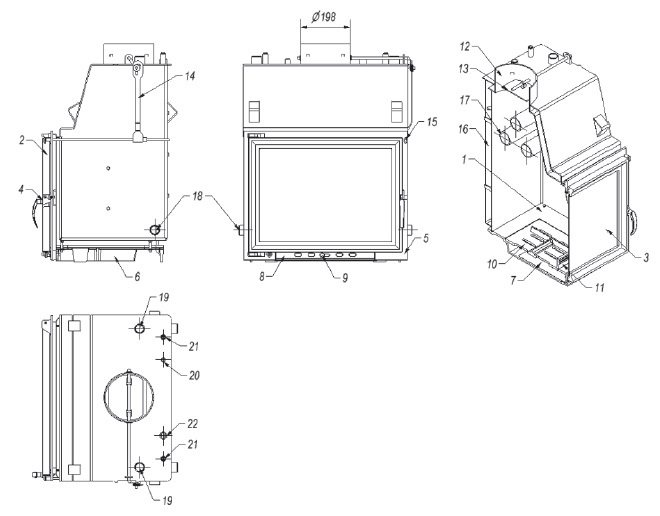

Components for a fireplace with a water heating circuit.
The regulation of the intensity of combustion of the energy carrier occurs due to the supply of primary air. The regulating function is performed by a window (8) in the ash pan and a manually controlled throttle (9). Secondary air necessary for the afterburning of gaseous combustion products of wood and solid particles, which rise along with the gas streams, enters through an opening in the tempered glass of the door.
A fireplace with a water heating circuit with their own hands is equipped with smoke tubes through which the smoke passes into the chimney (12). The obligatory attribute of the chimney is a regulating damper (13). The angle of its inclination is determined by a special mechanism (14). The supply of cold heat carrier from the heating circuit occurs through the lower branch pipes (18). The heated coolant leaves the fireplace through the upper nozzles (19). Branch pipes 20-22 are intended for installation of a coil, thermostat.
How are fireplaces with air ducts arranged?
A fireplace with air heating is simpler than similar equipment, but with a water circuit. That is why making the first option in artisanal conditions is much easier than making a do-it-yourself fireplace with water heating. This explains the popularity of the air circuit in private houses. Such wiring acts as an excellent alternative way to heat a room when the main (gas or electric boiler) has ceased to function for some reason.


Air heating method.
Fireplaces for air heating of a house are similar in structure to their counterparts with a water circuit. The process of removing combustion products from the system is of interest.
Chamber I. It is located under a metal convector. It is equipped with a fan that supplies hot air. The latter comes from the combustion zone. Chamber I is equipped with a series of pipes. They are mounted to the side walls of the fireplace chimney. These tubes end with valves. Such a device is necessary if the electricity is cut off and the supply ventilation stops working.
Camera II. Through it, cold air is drawn through the side grilles-fans of the outer shell of the fireplace. Cold air is heated by the metal body of the heating element and pipes through which the combustion products are removed. The chimney can be heated up to 700 ° C. It is in it that the final combustion of the gas formed as a result of fuel combustion and solid particles occurs.
In order to significantly increase the heat exchange between the chimney and the cold air entering chamber II, the surface of the former is increased by means of ribbed hoops. Also, the chimney is equipped with a damper. With its help, it is possible to mechanically regulate the draft in the fireplace, and, consequently, the intensity of combustion. From chamber II, warm air is either evenly distributed in the space near the fireplace through special holes, or enters the air ducts, which diverge from the heating element throughout the house.
Any home-made device is inferior to factory equipment in terms of efficiency and efficiency. That is why you need to trust the manufacture of fireplaces to specialists who have the appropriate education and experience in this field.
Camera III. Decompression chamber. It is necessary so that heating by a fireplace with an air duct is safe. It plays the role of an insulating space between the ceiling of the house and the hot chimney.
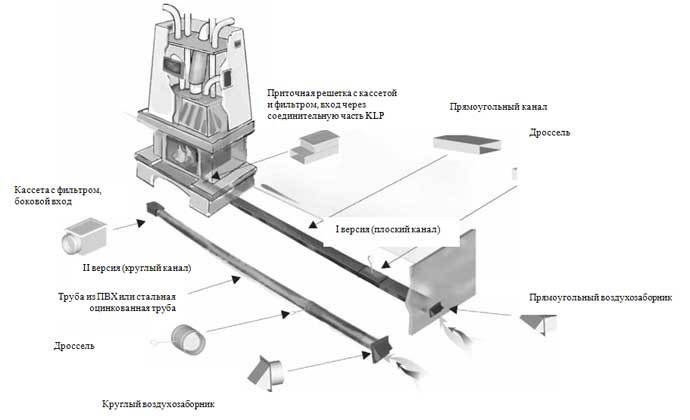

Air-heated fireplace piping.
How does a fireplace work?
The principle of operation of a fireplace with air ducts is based on the correct supply of fresh air from the outside and the timely removal of combustion products.
The air supply to the fireplace can be done in two ways:
- directly from the living quarters;
- using an air duct from outside the house.
The first method is easy to install. To do this, it is necessary to correctly calculate the area of the room where the fireplace is mounted, according to the power of its combustion chamber. So, for the combustion of 1 kg of wood, 8 cubic meters of air is needed. Based on this, it is easy to calculate that a heating element with an average power should be installed in a room with a cubic capacity of at least 30 cubic meters. Otherwise, unfavorable conditions for human life and even an emergency situation are created in the house.
The advantage of the second method is that there is no relationship between the power of the equipment and the cubic capacity of the room where it is installed. In this case, combustion air is taken from the street. For this, round or rectangular air ducts made of galvanized steel or PVC material are laid under the floor in the house to the fireplace. At the end of the pipe facing the street, there should be a grill. It protects the air duct from rodents and insects. Filters are also important in this case. They are designed to clean the supplied air from dust. They are installed in the valve directly in front of the fireplace.
How to make a false fireplace with your own hands
How nice it is sometimes to gather in the evening by the fireplace with the whole family. Play a board game together or have a warm evening conversation. Or maybe, on the contrary, to retire from the outside world, wrapped in a blanket with a cup of hot chocolate, and, looking at the dance of fire, plunge into sweet melancholy. How delightful these moments of bliss and relaxation are. But not everyone has a fireplace: someone is prevented by the lack of space, someone cannot afford it, for someone there are difficulties with the arrangement of the fireplace itself, and someone simply lives in an urban-type apartment. If the installation of a real fireplace is difficult, there is an option to install a false fireplace.
False fireplaces are convenient in that they outwardly partially or completely repeat real fireplaces. And, despite the fact that they are just a parody, they have their advantages. The main distinguishing features of false fireplaces are: imitation of fire, hence the second difference - the absence of a chimney. In addition, the operation of such fireplaces is much safer.
Types of false fireplaces
In view of the different level of complexity of the design, conditionally false fireplaces are divided into three main types. False fireplaces should not be confused with an eco-stove and animated hearths - together with a decorative portal, they are components of a full-fledged concept of a false fireplace.
Types of false fireplaces:
- Reliable
- Conditional
- Symbolic
Reliable.
This is a fireplace model that is closest to the original version. The function of such a false fireplace is to give the guest the impression that there is a real fireplace in front of him. And the luxurious cladding sets the status to the owner. And it doesn't matter from what improvised means it was made. However, it is precisely in the creation, processing and arrangement of a portal of this type that the complexity lies. The design of the appearance is more often entrusted to designers, and construction is more often entrusted to the masters of their craft.
So, how does this type differ from the other two, except for appearance.This model provides for the obligatory presence of a deep niche. It is in such a false fireplace that you can install an eco-stove, biofireplace, photo frame with fire. And the parody is not inferior to the original in terms of functionality. In addition to the external impression and creating the illusion of coziness, the fireplace also gives warmth. The key point here is that the entire process is soot and smoke free. The only nuance of such a fireplace model is the cost of its creation.
Conditional.
It is much easier to create a conventional fireplace model. A shallow niche in the wall is enough for this. The portal can be made of any material, for example, foam, drywall, someone even makes from old cardboard boxes. Or it may be absent altogether, in which case the boundaries of the niche act in its role. Fire in this type of fireplace is replaced with a photo frame or, more often, with candles. Be careful with candles, especially if the portal is made of flammable material. But the most interesting design ideas are logs wrapped in a garland, or small candles inserted into them. And if you mirror the back wall of the niche, then it becomes even brighter in the hearth, and a full-fledged feeling of evening comfort is created.
Symbolic.
This type of false fireplace differs from the others in that the presence of a fire in it is optional. Such a fireplace can freely be a wall sticker or a picture. Especially in such cases, the shelf nailed over the fireplace pattern looks beautiful and original. If you put objects on it, this will give visual volume to the element, and it will seem that the fireplace is like a real one. Another advantage of symbolic fireplaces is their location in the house. Traditionally, fireplaces are placed in living rooms and bedrooms, but this type can be placed anywhere: kitchen, nursery, bathroom - why not?
Having looked at such colorful photographs of fireplaces, the idea of making your own fireplace involuntarily comes to light. Now that we are familiar with the types of false fireplaces, we will take a closer look at the materials, device, competent location, or in other words - where to start and what to pay special attention to.
Do-it-yourself false fireplace
It is not so difficult to create your own dummy fireplace. Everyone can cope with this task - there would be a desire. But first of all, you need to decide on the future. place
for construction. If the room is small, it is recommended to install a corner fireplace, if it is large, then in the center of the room and preferably perpendicular to the windows. This is due to the fact that the light falling on the fireplace will drown out all the charm of the fireplace itself. It is also worth paying attention to
the size
conceived design: if it is bulky, then the room should be spacious, otherwise there will be a large load on the space. Conversely, a small fireplace in a room that is too spacious can get lost.
Not worth mixing styles
... Pay attention to the general background of the main interior. The fireplace must fit into it competently. After considering all of the above, create
sketch
the way you see the finished fireplace in the selected place. It can be a sketch on paper, a light sketch, or you can design a model of your room with a fireplace using computer programs. Elementary: in a graphic editor, overlay the fireplace model on the photo of the room. Thus, we will see an approximate result, which we will strive for.
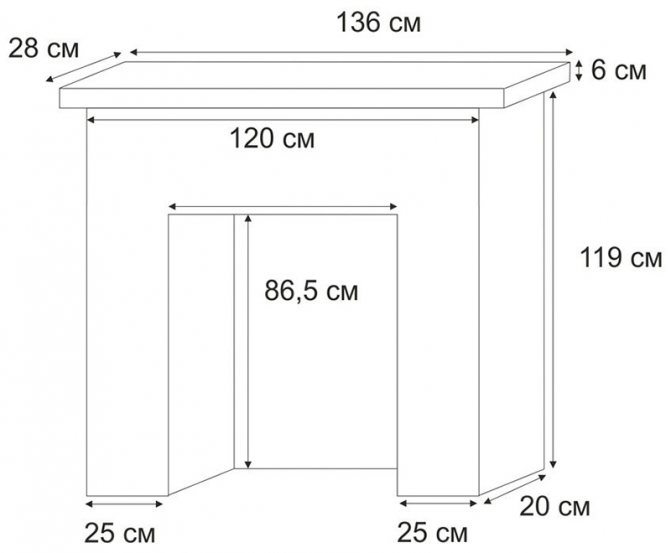

Next are the measurements and the image of the detailed drawing
fireplace. The dimensions of the future fireplace will come from the dimensions of the room in which it will stand. After your drawing is ready, we decide on
material
and prepare the necessary
tools
.
You may need:
- Screwdriver
- Jigsaw
- A circular saw
- Renovator
- Reciprocating saw
- Self-tapping screws
- Glue gun
- Paint brush
And this is the main list of tools; others can be involved in the course of work.
Material.
You can start with a simple material for the portal: drywall, chipboard, plywood or cardboard. A metal profile can be used for stitching. If cardboard is used for the construction, then it is fastened with construction tape and glued. When building from wood, a metal frame should be installed for reliability.


Next comes facing
... There is already a free flight of fantasy. You can create an imitation of brick laying in different ways: cut rectangles from foam, draw inter-brick space (white stripes), cut out cardboard "bricks". If you glue styrofoam decor elements (platbands, stucco moldings, etc.) to the frame and paint it correctly, you will get an elegant fireplace in the English style.
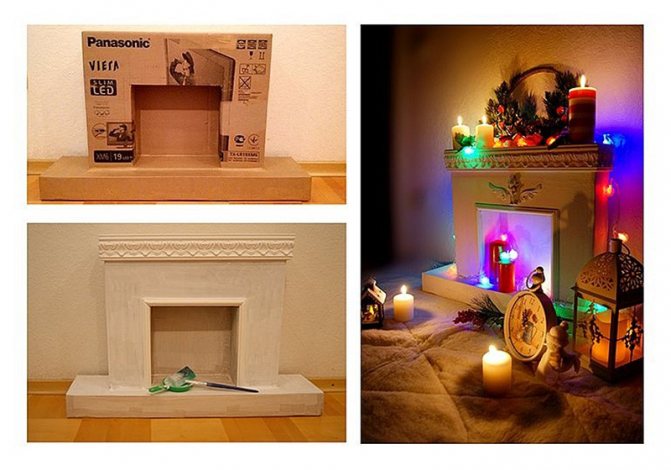

The next step is to design a niche. The back wall is laid out with mirror tiles, or a dummy of soot or a fire is painted on it. Next, they put candles (which is unsafe with a cardboard portal), lay out a garland or other luminous objects to create an entourage of a burning hearth. If the fireplace is of a conventional type, then you can lay out items to match the style of the interior (books, toys, spruce branches, etc.). The finishing touch can be additional elements such as a metal grate, a figurine or a book on the fireplace.
Here are the main points from the recipe "how to create a false fireplace with your own hands." It is not necessary to go to the hardware store for materials, look around, maybe they are already around you? Take a look at a selection of homemade artworks. Looking at such luxurious false fireplaces, you cannot say that they are made from a simple TV box, will you agree? So go for it! We are sure that you will definitely succeed. Good luck!


Which is better: a fireplace with a water circuit or with air ducts?
This question cannot be answered unequivocally. The advantages and disadvantages of both systems come from the characteristics of the heated room, the desired temperature regime in the rooms.
Heating fireplaces with a water circuit have the following advantages:
- efficiency;
- low cost;
- the contour of the fireplace can be easily integrated into the existing heating system of the house;
- the possibility of preparing hot water;
- low cost of equipment;
- low price of energy carrier.
A heating fireplace with a water circuit has disadvantages:
- low efficiency;
- the need for constant loading of the energy carrier;
- manual mechanism for adjusting the intensity of work.
If we compare fireplaces with open and closed combustion chambers, then the efficiency of the first is 20%, and the second is 70%.
A fireplace with air heating with your own hands is the easiest to make, because the equipment is not distinguished by a complex device. The very layout of the air ducts is also easy to organize. The room temperature is reached within a few minutes.
Disadvantages of a fireplace heating system with air ducts:
- constant circulation of dust in the house due to the operation of fans (in the case of forced air circulation);
- increased noise level due to air movement along the air ducts;
- the temperature in the room drops as quickly as it rose after the extinction of the fireplace;
- low efficiency;
- the need for manual control of the combustion reaction;
- the need for constant loading of the energy carrier into the furnace.
Heating a house with a fireplace with a water circuit and air ducts can be an excellent alternative source of heat, but not the main one. Such heating elements run on an inexpensive energy source. But fireplaces can be afforded by those people who are not too lazy to constantly throw firewood into the firebox, control the intensity of their combustion and periodically clean the chimneys.
Productivity increase
To increase the performance of the fireplace stove you need:
- Heat with dry wood. Energy will not be spent on drying firewood and heating the furnace, which is cooled by condensation.It is recommended to dry firewood in the open air for at least a year after logging, and shortly before use, bring it into a warm room.
- Prefer hardwood hardwoods (burns longer and gives more heat). Suitable options are birch, ash, oak, apple.
- Remove ash from the firebox regularly and clean the chimney at least twice a year to ensure good draft and uniform air flow to the logs.
- Monitor the tightness of the fireplace stove and chimney. Through the slots along the door contour and at the joints, cracks in the body and pipes, excess air enters the firebox and chimneys, which increases the speed of firewood combustion and the removal of hot gases. In addition, the operation of leaky equipment is unsafe: the risk of fire and the ingress of carbon monoxide gases into the room increases.
Typical diagrams for connecting a fireplace to a heating system
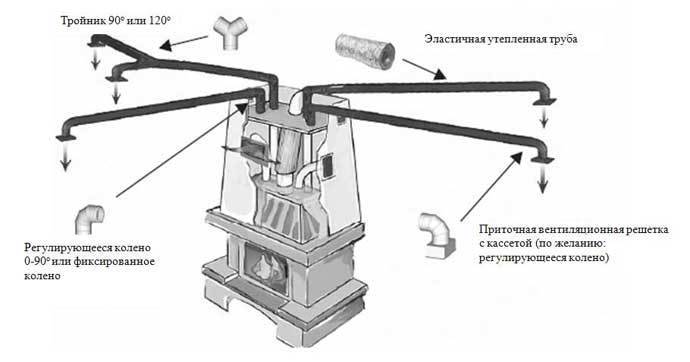

Gravitational convection.
To maximize the efficiency of the fireplace and efficiently distribute the heat generated in its combustion chamber throughout the house, it is necessary to integrate the fireplace into the heating circuit of the house (in the case of a fireplace in a water shirt). Fireplaces with air ducts require a special development of the heating elements.
The scheme of air heating by a fireplace depends on the area of the served area. So, gravitational wiring is suitable if the area of the room that needs heating is very small. The length of the air ducts should not exceed 3 m in length. In this case, the air heated by the fireplace will rise through the channels, displacing cold air at the ends of the pipes.
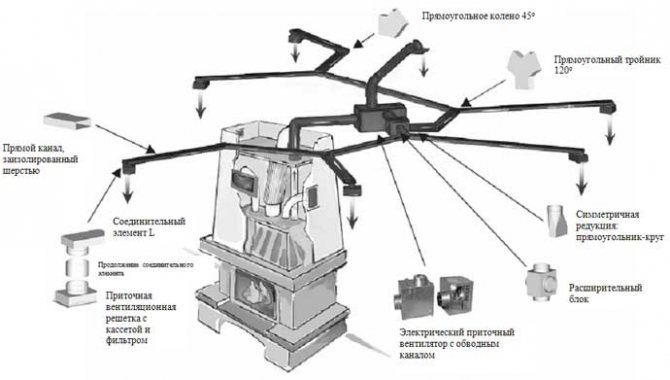

Forced convection.
This circuit is completely non-volatile, easy to design, install and use. Requirements for its installation: the length of the air ducts should not exceed 5 m, the pipe itself should be flat with a minimum number of turns. The material of construction for the pipes should be refractory aluminum capable of withstanding a temperature of 250 ° C. Thermal insulation of the duct body is required.
The contour with forced air movement, although it is more expensive in execution, compared to the gravitational analogue, it allows you to heat a large area of the room. At the same time, the complex layout of the house will not affect the efficiency of the system. In addition to air ducts, this circuit is completed with elements of supply ventilation (as the main driving mechanism of warm air), connecting nodes and corners, all kinds of elements for controlling directed air flows.
Is the use of fireplaces in the home effective?
Any fireplace is, first of all, a decorative element of the interior, which, thanks to modern developments, is able to effectively participate in heating the premises. So, heating a house with a fireplace with an air duct has a simple structure and an equally simple principle of operation, and therefore it is inexpensive. However, the low efficiency of the circuit sometimes casts doubt on the entire expediency of erecting such a structure.
The principle of operation of a fireplace with a water circuit, as well as the structure of the heating element itself, is more complicated than the previous version, which explains the high cost of both equipment and installation work. However, the efficiency of 70% of fireplaces with a water circuit makes this equipment an excellent alternative source of heat in the house when the main heating element (boiler) is turned off. How to properly install a fireplace with a water circuit will help you understand the video:
P.S. And remember, just by changing your consumption - together we are changing the world! © econet
